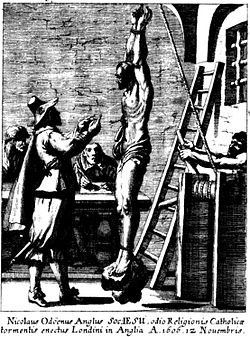Nicholas Owen (martyr)
| Saint Nicholas Owen, S.J. | |
|---|---|

The torture of Saint Nicholas Owen, S.J.
an engraving by Melchior Küsel (17th century) |
|
| Forty Martyrs of England and Wales | |
| Born | c. 1562 Oxford, Kingdom of England |
| Died | 1/2 March 1606 Tower of London, Kingdom of England |
| Venerated in |
Roman Catholic Church (England and Wales) |
| Canonized | 25 October 1970, Vatican City, by Pope Paul VI |
| Feast | 22 March; Jointly: 4 May (England) and 25 October (Wales) |
Saint Nicholas Owen, S.J., (c. 1562 – 1/2 March 1606) was a Jesuit lay brother who was the principal builder of priest holes during the reigns of Queen Elizabeth I and James I of England. After his final arrest, he was tortured to death by prison authorities in the Tower of London. He is honoured as a martyr by the Catholic Church and was canonized by Pope Paul VI in 1970.
He was born in Oxford, England, around 1562 into a devoutly Catholic family and grew up during the Penal Laws. His father, Walter Owen, was a carpenter and Nicholas was apprenticed as a joiner in February 1577 where he acquired skills that he was to use in building hiding places. Two of his older brothers became priests.
Owen served as Edmund Campion's servant and was arrested for protesting Campion's innocence. Upon his release, he entered the service of Henry Garnet S.J. around 1588 and for the next 18 years built hiding places for priests in the homes of Catholic families. He frequently traveled from one house to another, under the name of "Little John", accepting only the necessities of life as payment before starting off for a new project. He also used the aliases "Little Michael", "Andrewes", and "Draper". During the daytime he would work as a travelling carpenter to deflect suspicion.
Owen was only slightly taller than a dwarf, and suffered from a hernia, as well as a crippled leg from a horse falling on him. Nevertheless, his work often involved breaking through thick stonework; and to minimize the likelihood of betrayal he often worked at night, and always alone. Sometimes he built an easily discovered outer hiding place which concealed an inner hiding place. The number of hiding places he constructed will never be known. The location of the secret room was known only to himself and the owner of the house. Examples of his work survive at Sawston Hall (Cambs),[Oxborough] [Norfolk] Huddington Court (Worcestershire) and Coughton Hall (Warwickshire).Harvington Hall in Worcestershire has seven "priest holes". Due to the ingenuity of his craftsmanship, in some houses they may still be undiscovered.
...
Wikipedia
